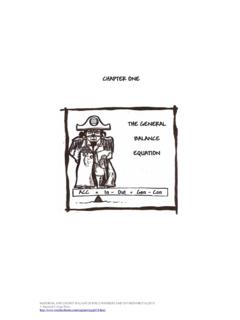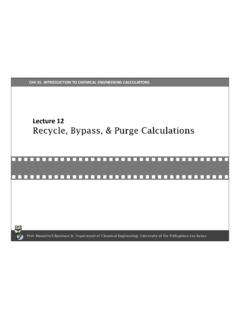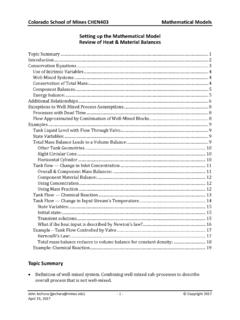Transcription of The Material Balance for Chemical Reactors
1 4 The MaterialBalancefor GeneralMoleBalanceConsideran arbitraryreactorvolumeelementdepictedin ,whichhas inletand outletstreamswithvolumetric owratesQ0andQ1, molarconcentrationsof componentjin the twostreamsare givenbycj0andcj1and the productionrate of componentjdue to chemicalreactionsisRj. The statementof conservationofmassfor this systemtakesthe form,8> <>:rate ofaccumulationof componentj9>=>; (rate of in owof componentj) (rate of out owof componentj) 8> <>:rate of generationof componentjbychemicalreactions9>=>;( ) MaterialBalancefor ChemicalReactorsIn termsof the de nedvariables,we can as,ddtZVcjdV Q0cj0 Q1cj1 ZVRjdV( ) appliesto everychemicalcomponentin the system,j 1;2.
2 Ns, includinginerts,whichdo not take placein any can, of course,includevolumeelementswithmorethan two owstreamsby summingwiththe appropriatesign over all streamsenter-ing and leavingthe the balancesin this chapter,therewillbe two or fewer that we are assumingthatcomponentjentersand leavesthe reactorvolumeelementonlybyconvectionwith the in owand out particular,we areneglectingdiffusional ux throughthe boundaryof the volumeelementdue to a diffusional ux will be consideredduringthe developmentof the materialbalancefor the solvethe reactormaterialbalance,we requirean expressionfor the productionrate,Rj, for Chapter2, the productionrate can be computeddirectlyfromthe stoichiometryand the reactionratesfor all reactions,ri.
3 Thereforewe requirean expressionfor the reactionratesin termsof the concen-trationsof the majorityof the purposesof illustratingthe materialbalancesin this chapter,we simplyuse expressionsmay be regardedas empiricalfactsuntilthe next chapterwhenthe theoreticaldevelopmentof the rate expres-sionsis The BatchReactorThe batchreactoris assumedto be well stirred,so thereare no con-centrationgradientsanywherein the this case it isnaturalto considerthe entirereactorcontentsto be the reactorvolumeelementas in , andV VR. Becausethe reactoris well stirred,the integralsin are simpleto evaluate,ZVRcjdV cjVR( )ZVRRjdV RjVR( ) The reactoris chargedwith reac-tantsatt 0, and nothingis addedorremovedfromthe reactoruntilthe stop-ping time,the in owand out owstream owratesare zero,Q0 Q1 Equa-tion givesthe generalbatchreactordesignequation,d cjVR dt RjVR( ) applieswhetherthe reactorvolumeis constantor changesduringthecourseof the the reactorvol-umeis constant,whichis sometimesagoodapproximationfor liquid-phasereactions,VRcan be dividedoutof bothsidesof to givedcjdt Rj( )
4 Be sure to use if the reactorvol-ume changessigni cantlyduringthe courseof the SimpleRateLawsIn complexand realisticsituations,the materialbalancefor the batchreactormustbe ,if the reactoris iso-thermal,and the rate lawsare assumedto be quitesimple,thenan-alyticalsolutionsof the materialbalanceare valuablefor at leasttwo ,due to the closedformof the solution,analyticalsolutionsprovideinsig htthat is dif effectof parametervaluesonthe solutionis usuallymoretransparent,and the carefulstudyof ana-lyticalsolutionscan oftenprovideinsightthat is hardto ,evenif one mustcomputea numer-ical solutionfor a problemof interest,the solutionprocedureshouldbe checkedfor errorsby comparisonto an analyticalsolutionfor a simpli edproblemprovidessomeassurancethat the veri SomePFR-CSTRC omparisons1611r c0A :To achievethe sameconversion,the CSTRis smallerthanthe PFR for irreversible,nth-orderkinetics,nega-tive order,n < : The PFR versusCSTR withseparationWe havenoticedthat a PFR achieveshigherconversionthanan equiva-lent volumeCSTRfor the irreversiblereactionwith rst-orderkineticsA-!
5 Br kcAConsiderthe case in whichwe add singleCSTR andseparatorcombinationthat achievesthe sameconversionas the may assumea perfectseparationof A and B, the feed is a pureAstream,andk 1 for the PFR achievesa fractionalconversionof AxPFR 1 NA=NA0 1 exp k 0:632 For an equivalentvolumeCSTR withoutseparation,the conversionofA isxCSTR 1 NA=NA0 k = 1 k 0:5 The goalis to increasethe achievableconversionin the chemicalengineeringprinciplesleadsone im-mediatelyto considerrecycleof the unreactedA as a meansto increasethis owsheetdepictedin frac-tion of the out owfromthe CSTRis recycled,the productB is removedand the unreactedA is combinedwith the feed as the in owof the MaterialBalancefor ChemicalReactorsNA0NA1NA2 NANA0NA NA2.
6 PFR versusCSTR with recycleand assumptionof perfectseparation,we can achieveessentiallycompleteconversionof A fork 1 with completerecycle,so our goalhereis to calculatethe fractionalrecycle, , that achievesexactlythePFR <1 the achievableconversionis less thanoneas discussedin rst that the meanresidencetimeof the CSTR, 0, is lessthanthat for the PFR, , becausethe owratehas increaseddue tothe withperfectseparation,pureA streamsarecombinedat the mixer,andQ0=Q1 NA0=NA1so 0 VR=Q1 VR=Q0 Q0=Q1 NA0=NA1We mayconsiderfourvariablesto specifythe stateof the system: ;NA1;NA2;NA; and we can writethreecomponentA materialbalancesfor the reactor,splitterat reactorexit and mixerat reactorinletreactor:NA2 NA1= 1 k NA0=NA1 splitter:NA 1 NA2mixer:NA1 NA0 NA2 The separatorbalanceis trivialbecausethe separationof A is perfect,and,therefore,the molar owof A is conservedacrossthe SomePFR-CSTRC omparisons163per passoverallxAxCSTRxPFR :Overalland per-passconversionof A as a functionoffractionalrecycle.
7 Inlet owof A is not speci ed,it is convenientto dividethe precedingequationsbyNA0, de nedimensionlessmolar ows,and rearrangeto obtainreactor:NA2 1 k =NA1 NA1 0splitter:NA 1 NA2 0mixer:1 NA2 NA1 0( )We can specifya singlevariableas knownand solvefor the remainingthreewiththe example,if we specifythe recyclefraction, , we can forNA;NA1;NA2, and computethe conversionfromxA 1 NA. resultingconversionof A plottedas a functionof . We can see the PFR conversionis achievedat about 0:65. If we wantamoreaccurateanswer,we can setNA exp k 0:3678and solve164 The MaterialBalancefor ChemicalReactorsnumericallyfor ;NA1;NA2, with , and the resultis 0:6613 is motivatedby a recentresultof Feinbergand Ellisoncalledthe CSTR equivalenceprincipleofreactor-separators ystems[4].
8 This surprisingprinciplestates:For a givenreactionnetworkwithnilinearlyindepe ndentre-actions,any steadystatethatis achievableby any reactor-separatordesignwithtotalreactorv olumeVis achievablebya designwithnot morethanni 1 CSTRs, also of totalreac-tor volumeV. Moreoverthe concentrations,temperaturesandpressuresi n the CSTR sare arbitrarilycloseto thoseoccurringin the reactorsof the principleto the last example,we knowthat any achiev-able concentrationof the PFR for a singlereactionis achievablewithaCSTRand numberof CSTR scan be reducedfromni 1 toniin certainsituations,suchas the one consideredin Exam-ple And we knowthe concentrationin the CSTR will be achievedsomewherein the StochasticSimulationof ChemicalReactionsWe wishto introducenexta topicof increasingimportanceto chemi-cal engineers,stochastic(random)
9 Stochasticmodelswesimulatequitedirectlyt he randomnatureof the willsee that the deterministicrate lawsand materialbalancespresentedin the previoussectionscan be capturedin the stochasticapproachby allowingthe numbersof moleculesin the simulationto viewpoint,deterministicand stochasticapproachesare solutionmethodsarequiteef cientwhenthe numbersof moleculesare largeand the ran-dombehavioris not numericalmethodsfor solutionof the nonlineardifferentialequationsof the deterministicmodelsare1 Noteone can solvethis simpleproblemanalyticallyas NA2fromthe secondand thirdequationsin resultinto the rstequationand solvethe StochasticSimulationof ChemicalReactions165also stochasticmodelingapproachis appropri-ate if the randomnatureof the systemis one of the importantfea-turesto be capturedin the becomingin-creasinglyimportantto chemicalengineersas we
10 Explorereactionsatsmallerand example,if we are modelingthechemicaltransformationby reactionof onlya few hundredsor thou-sandsof moleculesat an interface,we may wantto examineexplicitlythe random biologicalproblems,we oftenconsiderthe interactionsof only severalhundredor severalthousandproteinmoleculesand sterilizationproblems,we may wishtomodelthe transientbehavioruntileverylast organismis is perhapsbest to illustratefeaturesof the stochasticapproachwitha the commoncase in whichwe haveon the orderof Avogadro'snumberof reactingmolecules,assumewehaveonly a hundredmoleculesmovingrandomlyin the gas phaseandwe wishto followthe reactionAk1-!









